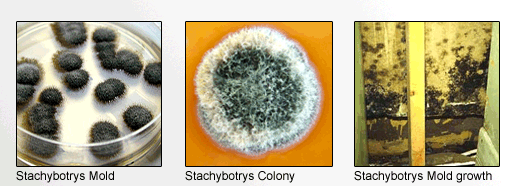| |
 |
| |
What
is Mold?
Mold is a microscopic organism, which grows from
spores. There are mold everywhere in our environment
but they are usually inactive. However, when the
relative humidity exceeds 60% they germinate and
multiply. As the mold develops, it produces enzymes
to digest organic materials including paper, books,
cloth, photographs, leather and wood. There are
100,000 different species of mold in the world.
Mold is part of the fungi kingdom; a realm shared
with mushrooms, yeast and mildews. How
does Mold Grow?
In order for mold to grow it needs a food source
such as leaves, wood, insulation, wallboard, drywall,
carpeting, clothing paper and dirt. In addition,
mold needs a source of moisture for at least 24
to 48 hours. Temperatures above 65 degrees Increase
the likelihood of mold growth in air quality conditions.
Below is a list of moisture sources that may Cause
mold problems.
•
Flooding
• Backed up sewers
• Leaky roofs
• Humidifiers
• Mud or ice dams
• Damp basement or crawl spaces |
•
Constant Plumbing leaks
• House Plants
• Steam from cooking or boiling
• Shower/bath on indoor dry lines
• Clothing dryers vented indoors
• Combustion appliances |
|
|
|
| |
How
do people get Sick from Mold?
Mold
grows everywhere, both indoors and outdoors. Most
often mold found indoors comes from outdoor sources.
Outdoor mold spores travel indoors through windows,
cracks, crevices or are carried inside on shoes
and clothing It is very common to find mold spores
in the air of homes and growing on damp surfaces.
We are all exposed to mold on a daily basis without
evident harm. However, health problems arise when
mold spores enter the air and then enter our bodies
enlarge numbers. For some people a relatively small
amount of mold spores can cause health problems,
and yet for others it may take a considerably greater
amount. The following are three ways mold spores
can enter the human body: Inhalation
through poor air quality conditions, digestion from
foods and water consumption where water restoration
is needed as well as a mold contractor.
|
|
|
| |
Which
Individuals have the Greatest Risk when Exposed
to Mold?
Exposure
to mold isn't’t healthy for anybody. However,
the following is list of individuals who appear
to have the greatest risk for adverse health effects
to mold:
•
Infants and children
• Elderly
• Immune compromised Patients
• Pregnant women
• Individuals with respiratory conditions
(Such as allergies, multiple chemical sensitivity
and asthma)
|
|
|
| |
Most
Frequent Health symptoms from Mold Exposure
•
Chronic Fatigue
• Headaches
• Memory loss, loss of concentration
• Difficulties in logical thinking and learning
• Clear, thin, watery mucus drips from nose
• Thick green slime coming from the nose
• Coughing, sore lungs/chest |
|
|
| |
Infection
from Mold
Although many mold fungi are harmless there are
now over 100 identified species that are known to
cause one of theses types of infections in humans:
• Systemic infection
• Opportunistic infection(mold parasites)
• Dermatophytes( a group of fungi that infect
the hair, skin and nails)
Opportunistic infection is usually a secondary result
of some other primary disease. Systemic infection
can be fatal to immune suppressed individuals. infection
by dermatophytes usually occurs through direct contact
with an infected person or indirectly by sharing
clothes, grooming utensils, etc. Infection is rarely
a result of the environment.
|
|
|
| |
Toxicosis
From Mold
Many
Fungi produce toxic metabolites called mycotoxins.
Dramatic and Carcinogenic effects have been recorded
for animals and humans exposed to high levels
of mycotoxins in laboratory studies do to poor
air quality conditions. Symptoms of exposure to
mycotoxins may include cold and flu like symptoms,
headache, nosebleeds, dermatitis and immune suppression.
Many mycotoxins are highly disease causing.
|
|
|
| |
| Air
Quality conditions can be monitored as well as water contractors
and mold contractors hired through Superior mold remediation
for water restoration areas. |
|
|







